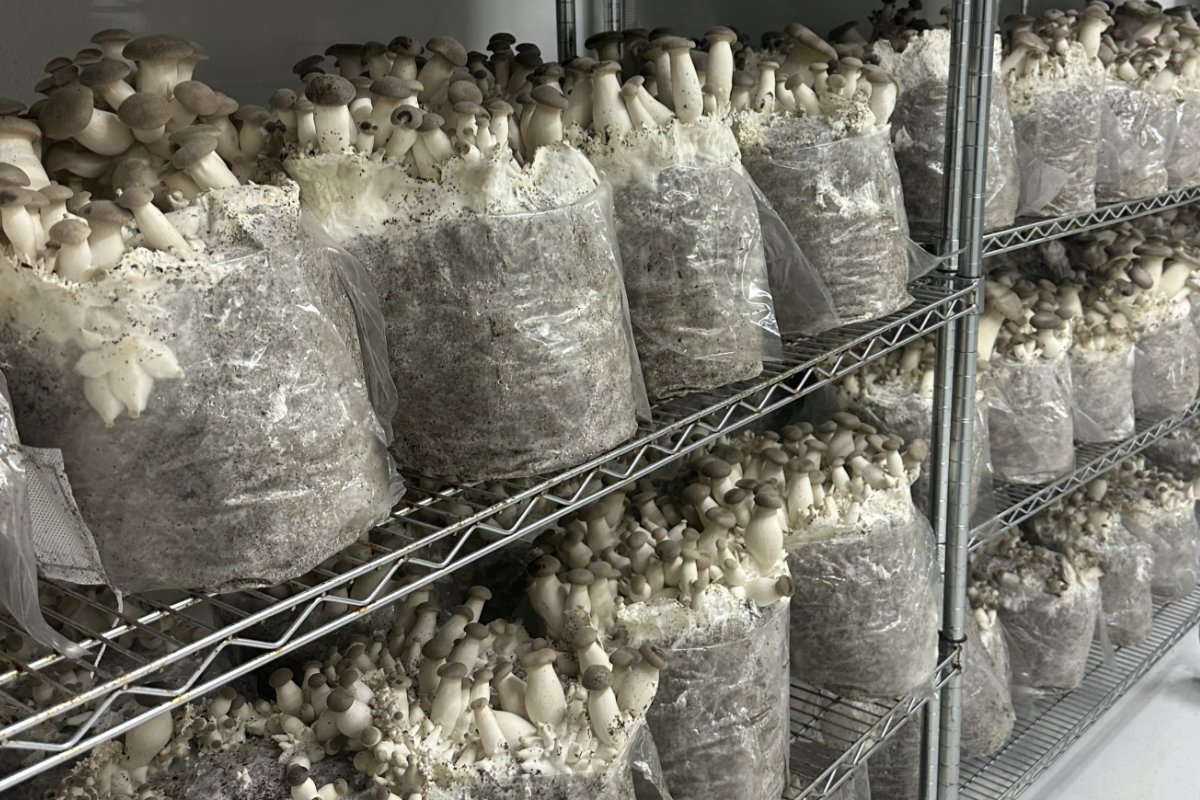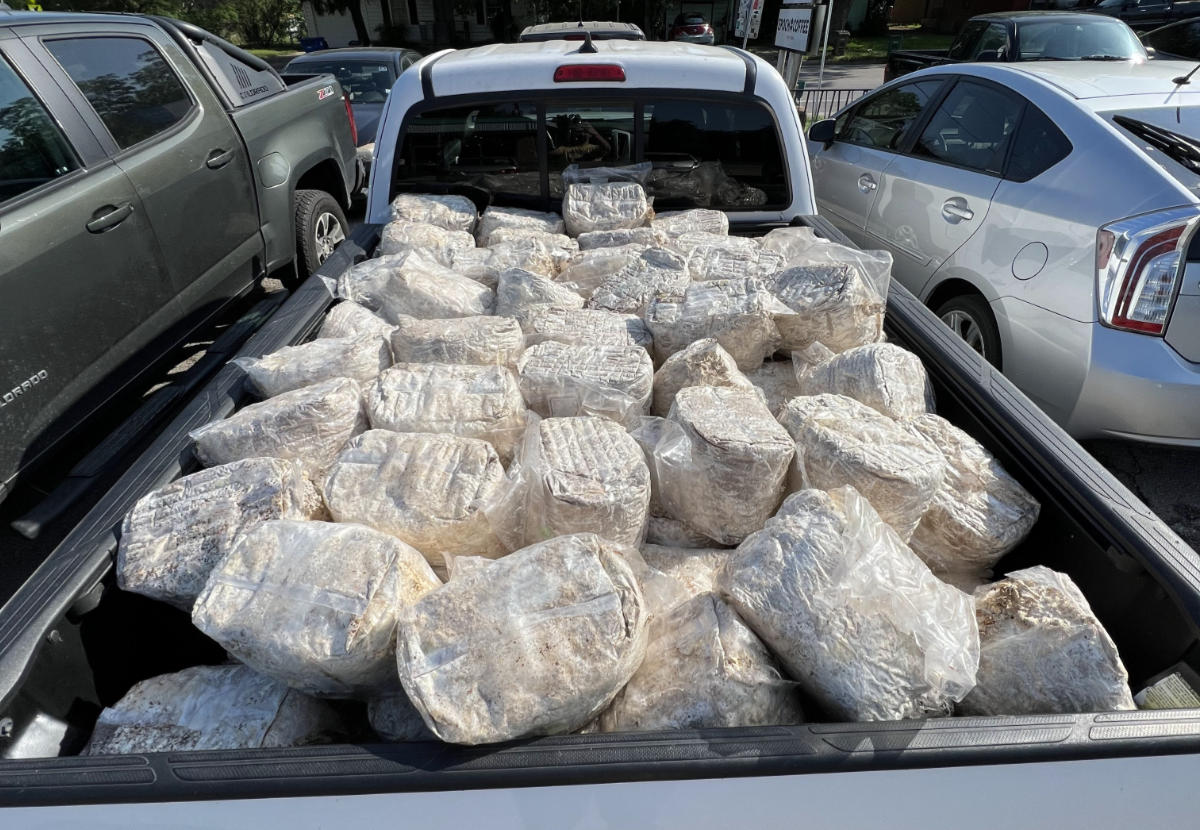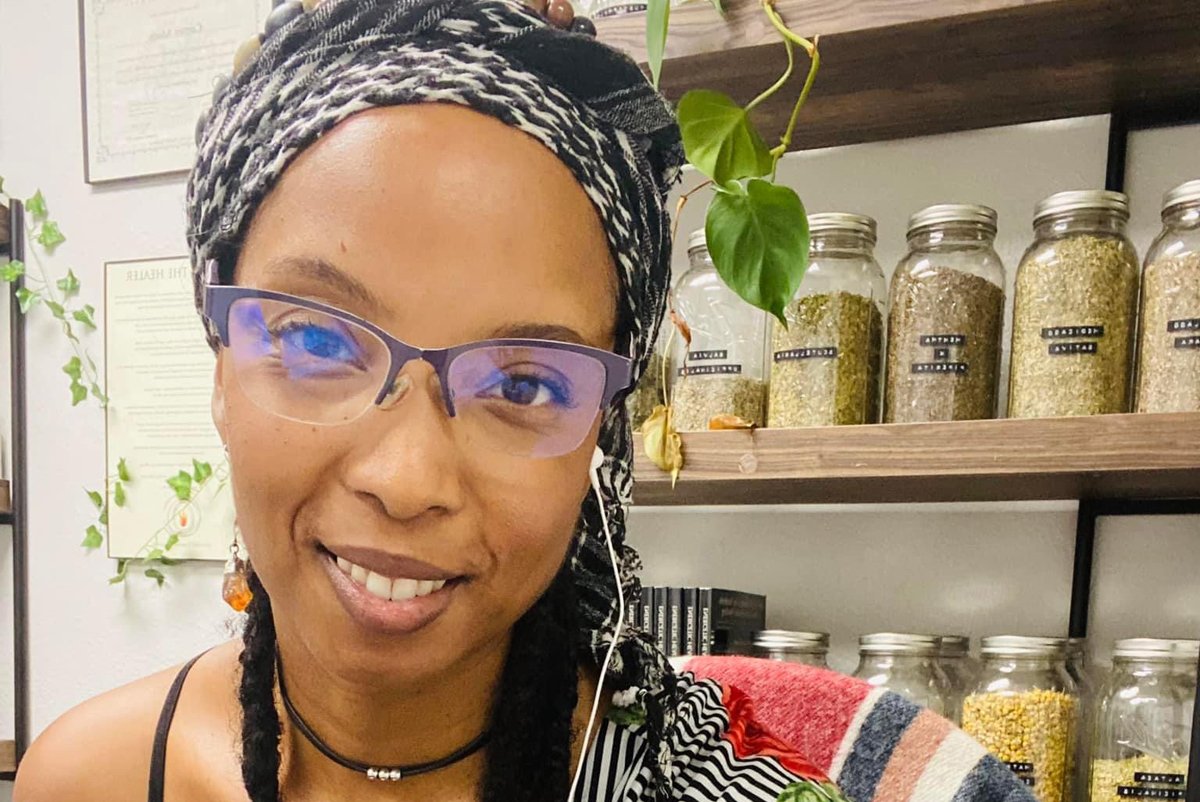As demand for mushrooms flush, can a circular economy take shape for their valuable, and copious growing medium?

As demand for mushrooms flush, can a circular economy take shape for their valuable, and copious growing medium?
March 19, 2024

Fruiting mushrooms in substrate. (Photo courtesy of Tivoli Mushrooms)
A version of this article originally appeared in The Deep Dish, our members-only newsletter. Become a member today and get the next issue directly in your inbox.
Collar City Mushrooms occupies a small building along the post-industrial waterfront of Troy, New York. Out back, baking in the winter sun between a shed and a yellow Volkswagen bus, sits a waist-high heap of what looks like dozens of giant Frosted Mini-Wheats, each roughly the size of a cinder block. The weathered caps of oyster mushrooms sprout defiantly from various points in the pile.
The lumpy blocks are spent substrate, the living material left over after growing mushrooms. Composed of sawdust and soy pellets woven through with mycelium—the thread-like aspect of the fungus from which mushrooms sprout—spent substrate is a unique kind of waste. It’s also one with many potential uses; it can be used as compost, as a means of decontaminating soil, as biofuel, and simply for growing more mushrooms. And while each of those uses could provide revenue potential for mushroom farms, the expanding piles of spent substrate also represent a mounting logistical challenge.
“If you’re gonna do it, awesome, but account for this waste stream you’re producing and how you’re gonna get it off of your property.”
“Right now, we have people picking it up almost as a favor for us, because otherwise what are we doing with it?” said Avery Stempel, Collar City’s co-founder, as we gazed upon the pile. Stempel currently takes most of the material to a nearby compost facility, but local farms, gardeners, and florists also take a portion. So do individuals, whether for compost in their gardens or just to grow mushrooms at home. “People will come and buy a bucket for five bucks,” Stempel said.
Before it’s put to work growing mushrooms, substrate is carefully mixed and sterilized to maximize efficiency and prevent competition for the fungus. Protected inside breathable plastic bags, the sawdust and soy hulls are inoculated with an edible mushroom strain, then stacked on racks in climate-controlled rooms. The bags are sliced open when the mycelium is ready, and out sprouts the first “flush” of mushrooms. To make the best use of space, many farms will dispose of the blocks after a single flush, but each block is capable of several rounds of mushroom production. In this sense, the substrate isn’t really “spent.”

Spent substrate waiting to be collected and reused. (Photo courtesy of Central Texas Mycological Society)
Collar City is a relatively small operation, producing up to 1,000 pounds of mushrooms a week. An hour south, in Hillsdale, New York, Tivoli Mushrooms produces around 20,000 pounds per week, and it’s currently only using half the capacity of its new 15,000-square-foot facility. Soon after moving in, Co-founder Devon Gilroy reached out to a neighboring organic farm, offering the spent substrate for free as compost if they would simply take it off his hands. It wasn’t a tough sell. “They showed up like two weeks later with a tractor and a big truck to load it in,” he said. “They insisted on paying us for the substrate, which really helped.”
From a revenue perspective, specialty mushroom substrate’s greatest value is currently as compost, which can sell for around $150 per cubic yard. It has a low pH level, useful in soils with low acidity, and a carbon-to-nitrogen ratio of roughly 40 to 1, which is close to ideal for building healthy soil. Spent substrate is also a useful addition to vermicompost—worms love to eat mycelium, and in doing so, they also break down woody debris and support soil biodiversity. It is also an excellent addition for structure and water retention.
But that doesn’t mean every mushroom farm has an easy time finding a second life for its spent substrate, and the quandary of how to make use of the material is growing along with the scale of the specialty mushroom industry.
“If you’re gonna do it, awesome, but account for this waste stream you’re producing and how you’re gonna get it off of your property.” That’s the advice Amanda Janney, founder of KM Mushrooms in California, offers new farmers. Janney’s farm is about as modest as they come, operating out of her home in Santa Rosa. As the farm’s output quickly grew, from 20 pounds of mushrooms a week to around 300, the leftover material quickly became a logistical problem to be solved.
“In the beginning when we were doing really low volume, it was not much of a consideration; giving bags of spent substrate out via Craigslist and Facebook Marketplace was sufficient,” said Janney. “Then production increased a lot faster than I had planned on, which is a great thing, but a big piece of it became connecting with farmers that were interested in [taking substrate] and getting a workflow to move it off the property quickly.”
In 2022, driven in large part by consumer interest in meat alternatives, global revenues for mushrooms were predicted to more than double to over $110 billion by 2030. The nutraceutical market for medicinal mushrooms—such as reishi, lion’s mane, and cordyceps—may follow a similar trajectory, with one forecast suggesting the market could triple to reach $62 billion by 2032.
The vast majority—95 percent—of the mushroom production in the U.S. is in Agaricus: the common cremini, button, or portobello (all the same species). Every other variety, be it shiitake or oyster, falls in the specialty mushroom category.
In the U.S., Agaricus mushrooms are produced in vast quantities by well-established farms, often generations old and mostly located in Kennett Square, Pennsylvania. Grown in a combination of manure and straw, they produce a distinct kind of spent substrate that is also used as compost, though it is a very different material from specialty mushroom substrate, with fewer applications. To farm button mushrooms cost-effectively is very labor- and space-intensive, and to take up producing them at small scales doesn’t make a lot of economic sense.
“It’s a huge opportunity on a spreadsheet, but on the operational side, it’s like, ‘Get this stuff out of here right now.’”
By comparison, it is relatively easy to grow enough oyster mushrooms to sell at market for more than $10 per pound, compared to around $5 per pound for button mushrooms. It’s also easy to buy a few ready-to-grow kits for home growers. For these and other reasons, specialty mushrooms are what most small and emerging farms are likely to grow. Sales of specialty mushrooms increased 32 percent between 2021 and 2022 alone, which means an equivalent increase in spent substrate, and more questions about what to do with it.
On the extreme end of substrate volume are the emerging mycelium materials companies, like MycoWorks and Ecovative. [Disclosure: The author worked for Ecovative in 2022 and 2023.] Based on oyster mushroom mycelium, Ecovative ships most of its substrate off as compost, and the possible uses it is exploring include selling part of the enormous output of leftover substrate to farms in Pennsylvania for a second act producing mushrooms.
There’s a limit to that market, though: “To be frank, you couldn’t possibly eat enough oyster mushrooms in the U.S. to use all the substrate we’re going to make if we meet our goal,” said Ecovative CEO Eben Bayer. “It’s a huge opportunity on a spreadsheet, but on the operational side, it’s like, ‘Get this stuff out of here right now.’”
Rather than relying solely on the market, the question of what to do with substrate is largely being answered by communities local to the specialty mushroom farms. In Austin, for instance, the Central Texas Mycological Society (CTMS) has organized a network of about two dozen locations for free spent substrate pickup. They report that some 9,000 people have signed up since the program started three years ago, with a surge during the pandemic, when interest in homegrown mushrooms took off dramatically.
“With spent mushroom substrate, we saw this opportunity to keep people connected,” said Angel Schatz, a lead organizer of the CTMS, whose front yard was the original drop-off point for the program. What people do with the material, though, is their own business. “I know a lot of people are growing the mushrooms, getting a second flush out of the bags, but we don’t want to steal the thunder from the commercial farms in any way, so we start first with teaching people the composting methods.”
Until recently, a significant amount of spent substrate for the CTMS pickup program came from Smallhold, which quickly became a prominent specialty mushroom grower over the last five years, before declaring bankruptcy in early February. With facilities in Los Angeles, Austin, and New York, the company’s objective was to grow specialty mushrooms near major cities. Each of its three large farms generated about 80 to 100 cubic yards of spent substrate per week, and the company employed a team dedicated to finding productive uses for the material.
“At the end of the day, this is a valuable material,” said Travis Breihan, who was the company’s impact manager in charge of researching uses for spent substrate. “But it is a new material on the scene, and it’s not like there was an established industry of people second-flushing blocks, or using it as a garden amendment, or even a larger-scale farm amendment. So, I think it’s early in the world of adoption, but all signs are very strong that it’s a great area of focus for the mushroom industry overall.”
CTMS isn’t concerned about losing the Smallhold substrate. “We still work with another farm that produces around 1,900 spent substrate blocks a week, and they will probably grow now because Smallhold won’t be here.
Meanwhile, besides giving away blocks, CTMS is working with local farms, food producers, and environmental remediation projects that utilize the material for cleanup of contaminated sites, such as the Circle Acres nature preserve on the edge of Austin.
Given the limitations that scale creates for transporting and productively using spent substrate, any future market for the material may indeed be shaped most by smaller operations. Specialty mushrooms lend themselves to this dynamic. They don’t ship well over long distances, and can run on the waste streams—such as sawdust—of nearby industries. It can take many different shapes and, crucially, sizes. As the specialty mushroom industry grows, spent substrate may find a market for secondary mushroom production, or for building and remediating soil and waterways. The potential of the material may best be realized in connecting mushroom production with other food- and soil-based initiatives, and in supporting more circular, regional economies.
“The least we can do is make sure the cycle is complete, and put it back into the soil rather than a dump site,” said Schatz.

September 4, 2024
By paying top dollar for milk and sourcing within 15 miles of its creamery, Jasper Hill supports an entire community.
September 3, 2024

August 27, 2024

August 26, 2024

August 13, 2024

Like the story?
Join the conversation.